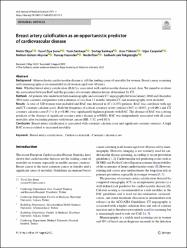Breast artery calcification as an opportunistic predictor of cardiovascular disease

Göster/
Erişim
info:eu-repo/semantics/embargoedAccessTarih
16.08.2022Yazar
Okşul, MetinŞener, Yusuf Ziya
Sarıkaya, Yasin
Sarıkaya, Sevtap
Yıldırım, Arzu
Canpolat, Uğur
Akpınar, Meltem Gülsün
Hazırolan, Tuncay
Özer, Necla
Tokgözoğlu, Sadberk Lale
Üst veri
Tüm öğe kaydını gösterKünye
Okşul, M., Şener, Y. Z., Sarıkaya, Y., Sarıkaya, S., Yıldırım, A., Canpolat, U., ... & Tokgözoğlu, S. L. (2022). Breast artery calcification as an opportunistic predictor of cardiovascular disease. Irish Journal of Medical Science (1971-), 1-7.Özet
Background Atherosclerotic cardiovascular disease is still the leading cause of mortality for women. Breast cancer screening
with mammography is recommended in all women aged over 40 years.
Aims Whether breast artery calcifcation (BAC) is associated with cardiovascular disease is not clear. We aimed to evaluate
the association between BAC and the presence of coronary atherosclerosis determined by CT.
Methods All patients who underwent both mammography and coronary CT angiography between January 2010 and December
2016 were screened, and patients with a duration of less than 12 months between CT and mammography were included.
Results A total of 320 women were included and BAC was detected in 47 (14.6%) patients. BAC was correlated with age
and CT coronary calcium score. Both the frequency of critical coronary artery stenosis (34% vs 10.6%; p=0.001) and CT
coronary calcium score (5.5 vs 0; p=0.001) was signifcantly higher in patients with BAC. The absence of BAC was a strong
predictor of the absence of signifcant coronary artery disease (p=0.001). BAC was independently associated with all-cause
mortality after excluding patients with breast cancer (HR: 5.32; p=0.013).
Conclusion Breast artery calcifcation is associated with coronary calcium score and signifcant coronary stenosis. A high
BAC score is related to increased mortality.















